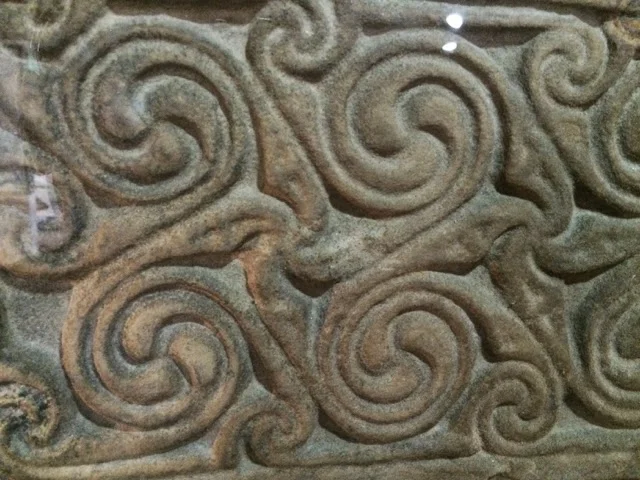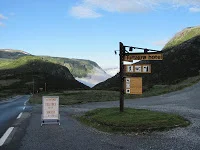The 2017 work year was a variety-pack of projects and travels bringing rocks and people together. Projects from 2017 now lie nestled in snow, while projects for 2018 are already underway.
Read MoreA family is held together by those things that their members share with each other. The “giving away” increases the closeness between individuals and tightens the family bonds. Mutual respect grows when a balance of give and take circulates within the tribe.
Read MoreA week on Sørvær in Northern Norway kept me immersed in the land and enveloped by the sea. The atmosphere of this island among islands is reigned by the sky above and waters below. Combined, they create an undeniably powerful influence. My moods changed at the whim of the weather. Even though I’ve spent my adult life working outdoors I’m unconditioned to the reality of light reflected from a vast and shifting water surface, or, tides streaming in and out all around. Grasping the totality of the archipelago's grand and sweeping vistas was a heady experience.
Read MoreA recent artist residency at AARK in Finland’s western archipelago allowed me the freedom to make something from nothing. There were no tools at hand and none of the materials I’ve grown accustomed to for making artworks. The islands were swept clean of loose stone by the last ice age, leaving a landscape of bedrock, worn smooth. Enough soil caught in low pockets to start the growth of the forest that now thrives there. It was in that birch and evergreen forest that I found my moss muse.
Read MoreAfter decades of assessing the attributes of inanimate objects in a direct and uncompromising way, I find myself in terrain where taking that path of least resistance only leads down a slippery slope to nowhere special. From a distance, the long way around appears to be inefficient and wasteful, but once the trip begins, the side tracks and stops along the way become the definition of the journey. The people met, the conversations had, the agreements made, are memorialized in the installation that’s left behind. They become the substance, if not the point, of the project. The public work now belongs to those who meander by, and will, I hope, become their memory touchstone.
Read MoreThe Pictish symbol for time depicts intertwined spirals, spooling outward in every direction from a centerpoint. They saw their movement through time as a dance with the past, in the present, with a nod to the future. For them, where each step is experienced looks and feels different from every other, but all are part of the same expanding destiny.
Read MoreUnlike the rugged upland landscape typically associated with the Highlands, the Tarbat is a low-lying peninsula of rolling ground that was, until recently by geologic time, a sandy sea bed. The rich dark soil supports extensive sheep pasturing, plus, oilseed rape, potato and barley production. Fields are outlined in dry stone walls (dry stane dykes) constructed from sandstone blocks lifted from the ancient bedrock found just under the soil in many parts of the Tarbat.
Read MoreThe whorling pattern of convoluted forms in the signet carved on the Cadboll Stone has a deep history. Before the pattern became emblematic of Picts culture, the earlier Celts employed a similar iconography in what is understood to be their graphic representation of time. If I think of the signet in terms of time, I see that for the Picts time was not linear. Time pulsed in a rhythm. Time unfolded and turned back on itself. The Cadboll signet lays out all of time’s manifestations in one picture. The concealed is present with the revealed.
Read MoreWhile visiting Scotland earlier this month I received a crash course in Pictish stone carving. The Picts lived north of what is now Edinburgh from the 1st to 3rd century AD. Little is known about them other than what can be deciphered from the system of symbols found carved on stones and engraved on metalwork. Nearly 200 stones survive, including the Hilton of Cadboll Stone that now resides in the National Museum of Scotland. After viewing the original Cadboll stone I met sculptor Barry Grove who was commissioned to carve a new stone, sited at the Cadboll Stone’s place of origin outside the royal burgh of Tain, just north of Inverness.
Read MoreDriving on the left side of the road, rubber sink-stoppers on a chain, grilled tomatoes for breakfast; these are some of the things to get used to, quickly, when on a six-day visit to the UK. I was there to take part in the DSWA Standardization and Assessment weekend for craftsman scheme examiners. Along the way, E. and I took in two of the three legs of the “Yorkshire Sculpture Triangle.”
Read MoreWhile the Standardization can be a bit stressful and nerve wracking at times, I look forward to reuniting with a great group of professional wallers.
Read MoreEvery baker knows it takes good ingredients to make a tasty pie. Now that plans for the dry stone workshop at Turtagrø, Norway have come together, I can see that our week in July is going to be a fantastic time. We have a beautiful setting, excellent accommodations and an abundance of building stone. All that’s missing are a few more enthusiastic folks to sign up and meet us at Tutagrø. I hope you will be the one who completes the pie!
Read More“Walls of Snowdonia”; it could be the title of a fantasy video game featuring my stoneworks. But, no, Snowdonia is a real place, and although I did make some stone wall repairs in Wales while visiting Philip Clark in the early 1990’s those walls are not included in this folio of beautiful photographs by Peter Ogwen Jones, Walls of Snowdonia. In fact, these beautiful examples of the waller’s craft were constructed more than a century ago. They continue to stand as testaments to the enduring value, practical and aesthetic, of handmade structures in the living landscape.
Read MoreThe last day on our transcontinental journey begins in Twin Falls, Idaho. By this afternoon we should be at our Oregon destination for the installation of a sculpture at the Central Oregon Community College. The O.H. and I have tag-team driven from Eastern Newfoundland across three provinces and twelve states in the past week and a half with just a 2-day stop at home in Vermont to unpack and repack the car. The weather has been cooperative, only occasional rain-storms and wind gusts to impede our westerly progress.
Read MoreSculptor Markku “The General” Hakuri marshaled a merry band of art lovers in the destruction of the pieces he exhibited in the Kerava Art Museum this summer. The closing ceremony of the show included a parade of dismantled sculpture parts and their burning in a bonfire. After the fire died down we proceeded to tumble my sculpture “Wishing Wells”. From its conception, my piece was destined to be removed at the end of the show, so, we had a fun time pulling out stones and watching the well walls cascade to the ground. Most delightful was the musical sound made by the downpour of cobbles.
Read MoreThe previous post elicited a question from a reader about the dry stone cairn in the top photo. It’s a trail marker, one of hundreds found alongside the old routes in Norway for crossing the high country from one valley community to another. They are spaced approximately 50 meters apart to help guide those traveling in fog, snow or low light conditions. The pine poles atop them may be all that’s visible in a sea of winter white.
Read MoreFrom the glacier fed streams of Norway’s Jotunheimen mountains, I’ve traveled this past week to the low, wetlands of Denmark. In fact, I’m living in a 300 year-old house alongside a castle moat. This is the artist’s residence for TICKON, the environmental art park I’ll be working in for the next month. Yesterday 20 tons of stone was gathered from field piles and delivered by the tractor-wagon load to the site of my construction. Today the outline of the work will be established and guide frames erected.
Read MoreContinuing on the subject of sculpture gardens, here’s a nice example I saw yesterday outside the Art Museum in Lillehammer, Norway. Created in 1992 by Bard Breivik, the sculptured garden is a cascade of stone and water. It begins serenely on flat ground at the height of the space. There, a screen of vertical granite slabs encloses a dry courtyard, a green lawn is bisected by a flagstone path, and the water course begins by spilling from a granite monolith into a long, stone trough. The water descends in multiple streams through a series of channels to a reflecting pool at the bottom of a steep rockery. Breivik’s sculptured garden is a good example of art that interprets nature without imitating it.
Read More
















